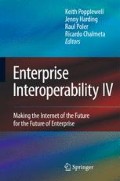Abstract
Decision-making on enterprise-wide information system issues can be furthered by the use of models as advocated by the discipline of enterprise architecture. In order to provide decision-making support, enterprise architecture models should be amenable to analyses. This paper presents a software tool, currently under development, for interoperability analysis of enterprise architecture models. In particular, the ability to query models for structural information is the main focus of the paper. Both the tool architecture and its usage is described and exemplified.
Access this chapter
Tax calculation will be finalised at checkout
Purchases are for personal use only
Preview
Unable to display preview. Download preview PDF.
References
The Open Group. The Open Group Architecture Framework, Version 8, 2005
Spewak, S.H., Hill. S.C., Enterprise Architecture Planning. Developing a Blueprint for Data, Applications and Technology, John Wiley and Sons, 1992
Zachman, J., A framework for information systems architecture, IBM Systems Journal, 26(3), 1987
DoD Architecture Framework Working Group, “DoD Architecture Framework” Version 1.0, 2003
NAF, “NATO C3 Technical Architecture”, Volume 1-5, Version 7.0, Allied Data Publication 34, 2005
L. Getoor, N. Friedman, D. Koller, A. Pfeffer, and B. Taskar. Probabilistic relational models. MIT Press, 2007.
Johnson, P., Johansson, E., Sommestad, T. Ullberg, J., A Tool for Enterprise Architecture Analysis, Proceedings of the 11th IEEE International Enterprise Computing Conference (EDOC 2007), 2007
Ekstedt, M. et al. A Tool for Enterprise Architecture Analysis of Maintainability, Proc. 13th European Conference on Software Maintenance and Reengineering, 2009
Object Management Group Object Constraint Language specification, version 2.0 formal/06-05-01, 2006
Chen, D. et al., Architecture for enterprise integration and interoperability: Past, present and future, Comput Industry (ind), 2008
IBM, Rational System Architect, http://www-01.ibm.com/software/awdtools/ systemarchitect/, accessed: Dec 2009
Scheer, A.-W., Business Process Engineering: Reference Models for Industrial Enterprises, 2nd ed., Springer-Verlag, 1994
International Organization for Standardization/International Electrotechnical Commission, “International Standard ISO/IEC 9126-1: Software engineering – Product quality – Part 1: Quality model,” ISO/IEC, Tech. Rep., 2001.
Clements, P., R. Kazman, M. Klein, “Evaluating Software Architectures: Methods and Case Studies”, Addison-Wesley, 2001
Gacek, C., “Detecting Architectural Mismatch During System Composition”, PhD. Thesis, University of Southern California, 1998
Kasunic, M., Anderson, W., “Measuring Systems Interoperability: Challenges and Opportunities” Technical Note, CMU/SEI-2004-TN-003, Software Engineering Institute, Carnegie Mellon University, Pittsburgh, 2004.
Ford, T., Colombi, J., Graham, S., Jacques, D., “The Interoperability Score”, Proceedings of the Fifth Annual Conference on Systems Engineering Research, Hoboken, NJ, 2007
Kurpjuweit, S., Winter, R.: Viewpoint-based Meta Model Engineering. In Proceedings of Enterprise Modelling and Information Systems Architectures (EMISA 2007), Bonn, Gesellschaft für Informatik, Köllen, pp. 143-161, 2007
Franke U. et. al, π-OCL: A Language for Probabilistic Inference in Relational Models (2010) to be submitted
ExoLab Group, The Castor Project, http://www.castor.org/ accessed Dec. 2009
Gagnon, É., SableCC, an Object-Oriented Compiler Framework, Master Thesis, McGill University Montreal, 1998
Decision Systems Laboratory of the University of Pittsburgh, SMILE, http://genie.sis.pitt.edu/ accessed Dec. 2009
IEEE, Standard Glossary of Software Engineering Terminology. Std 610.12-1990, The Institute of Electrical and Electronics Engineers, New York, 1990.
Author information
Authors and Affiliations
Editor information
Editors and Affiliations
Rights and permissions
Copyright information
© 2010 Springer-Verlag London Limited
About this paper
Cite this paper
Ullberg, J., Franke, U., Buschle, M., Johnson, P. (2010). A Tool for Interoperability Analysis of Enterprise Architecture Models using Pi-OCL. In: Popplewell, K., Harding, J., Poler, R., Chalmeta, R. (eds) Enterprise Interoperability IV. Springer, London. https://doi.org/10.1007/978-1-84996-257-5_8
Download citation
DOI: https://doi.org/10.1007/978-1-84996-257-5_8
Publisher Name: Springer, London
Print ISBN: 978-1-84996-256-8
Online ISBN: 978-1-84996-257-5
eBook Packages: EngineeringEngineering (R0)

